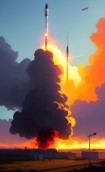|
Baconroll posted:So the Russians have removed nuclear warheads from missiles and then shot the missiles at Ukraine as just kinetic/fuel weapons. As I understand it, they're mostly shooting them to soak up SAMs from the actual strikes, but your point is valid, given the Russian record thus far, we can just set the countdown clock until unintentional dirty bomb.
|
|
|
|

|
| # ? Jun 5, 2024 17:47 |
|
Baconroll posted:So the Russians have removed nuclear warheads from missiles and then shot the missiles at Ukraine as just kinetic/fuel weapons. The Russians have been firing TBMs that are nuclear capable throughout this war, like Iskander, but have they started actually using weapons that were previously allocated to nuclear forces that have had the warheads removed? That seems like an interesting (and pathetic) escalation.
|
|
|
|
bennyfactor posted:The Russians have been firing TBMs that are nuclear capable throughout this war, like Iskander, but have they started actually using weapons that were previously allocated to nuclear forces that have had the warheads removed? That seems like an interesting (and pathetic) escalation. They’ve already been sending their nuclear silo guard force, iirc. Although if they keep wasting these missiles to soak up AA fire, they’ll deplete the intermediate scary missiles on top of everything else.
|
|
|
|
bennyfactor posted:The Russians have been firing TBMs that are nuclear capable throughout this war, like Iskander, but have they started actually using weapons that were previously allocated to nuclear forces that have had the warheads removed? That seems like an interesting (and pathetic) escalation. There have been cases of anti-intercept countermeasures dropped from iskanders, which should only be present if the payload is nuclear.
|
|
|
|
Please, use the proper term. It's also much funnier. PENAIDs
|
|
|
|
A.o.D. posted:It's an autocracy with oligarchical characteristics. It has to be from the Laconia region of Greece, otherwise its just Sparkling "Rule by the Few".
|
|
|
bennyfactor posted:The Russians have been firing TBMs that are nuclear capable throughout this war, like Iskander, but have they started actually using weapons that were previously allocated to nuclear forces that have had the warheads removed? That seems like an interesting (and pathetic) escalation. https://twitter.com/DefenceHQ/status/1596389927733927937
|
|
|
|
|
Russian General: "Yes Vlad we will be sending our nuclear missiles without payload as a warning to NATO" also Russian General: "Hello CIA, MI6? I trust that you received the package for study. I will be expecting my payment of iPhones and Trader Joes snacks in the usual dead drop location. Please use extra bubble wrap. It is hard to get now"
|
|
|
|
Alan Smithee posted:Russian General: "Yes Vlad we will be sending our nuclear missiles without payload as a warning to NATO" These particular weapons are obsolescent, and not worth much when studied. The Kh-55 (X-55 in cyrillic) entered service in 1981, and was began to be viewed as dated already in the late 80's. It started to be replaced with Kh-102 in 2012, with each missile replaced presumably moved from the strategic force stocks to the normal AF. So it's not shocking that Kh-55:s are being fired at Ukraine. What is shocking is that one of them still had a nuclear force training mass simulator in the head instead of a HE warhead.
|
|
|
|
Are nuclear warheads themselves impact/explosion resistant? Or is there a high likelihood of a radiological event if one of them isn't removed and craters into a grain silo?
|
|
|
|
psydude posted:Are nuclear warheads themselves impact/explosion resistant? Or is there a high likelihood of a radiological event if one of them isn't removed and craters into a grain silo? Well we've had more than a few warheads break apart in accidents, so while they are explosion resistant with enough damage you can spread the physics package material around, but they tend to be pretty resilient.
|
|
|
|
The one thing to keep in mind about nuclear bombs is that making a nuclear explosion is Hard, and bombs only make it happen through a lot of very precise mechanisms doing a lot of things in the correct order across a very short span of time on the order of milliseconds. Falling short of that, they're just regular bombs packed together with a few dozen kilograms of radioactive material. There'll be a hazmat cleanup job afterwards and probably some roadblocks within a kilometer of the location, but the fallout will be almost entirely political.
|
|
|
|
|
Yeah I'm less worried about accidental fission and more worried about an accidental dirty bomb.
|
|
|
|
psydude posted:Yeah I'm less worried about accidental fission and more worried about an accidental dirty bomb. Dirty bombs are, really, not much of a major concern, their fallout being more psychological than actual health impact. The threat of dirty bombs is more terrorizing than the weapon itself would be.
|
|
|
|
Slashrat posted:The one thing to keep in mind about nuclear bombs is that making a nuclear explosion is Hard, and bombs only make it happen through a lot of very precise mechanisms doing a lot of things in the correct order across a very short span of time on the order of milliseconds. Falling short of that, they're just regular bombs packed together with a few dozen kilograms of radioactive material. There'll be a hazmat cleanup job afterwards and probably some roadblocks within a kilometer of the location, but the fallout will be almost entirely political. good ones anyway. i can't imagine a modern implosion weapon accidentally detonating, but maybe you could maybe make a gun type bomb accidentally go off if you somehow inadvertently triggered the firing explosive? i figure anything that would has a good chance of busting the tube also and preventing the reaction masses from actually meeting properly, but it seems at least plausible that something could gently caress up and unintentionally set it off successfully
|
|
|
|
VSOKUL girl posted:good ones anyway. i can't imagine a modern implosion weapon accidentally detonating, but maybe you could maybe make a gun type bomb accidentally go off if you somehow inadvertently triggered the firing explosive? i figure anything that would has a good chance of busting the tube also and preventing the reaction masses from actually meeting properly, but it seems at least plausible that something could gently caress up and unintentionally set it off successfully Thankfully, there's very few, if any, gun type weapons in existence anymore.
|
|
|
|
CommieGIR posted:Thankfully, there's very few, if any, gun type weapons in existence anymore. Goon project
|
|
|
|
VSOKUL girl posted:good ones anyway. i can't imagine a modern implosion weapon accidentally detonating, but maybe you could maybe make a gun type bomb accidentally go off if you somehow inadvertently triggered the firing explosive? i figure anything that would has a good chance of busting the tube also and preventing the reaction masses from actually meeting properly, but it seems at least plausible that something could gently caress up and unintentionally set it off successfully But enough about the air force trying to nuke Goldsboro, NC  probably would’ve been an improvement for the area
|
|
|
|
RFC2324 posted:Goon project There's a running hypothesis that North Korea's first attempt at a nuke was a gun type device because they are just that easy to make. Dunno if Kim counts as a goon?
|
|
|
|
CommieGIR posted:There's a running hypothesis that North Korea's first attempt at a nuke was a gun type device because they are just that easy to make. Wouldn't surprise me. A gun bomb works fine if you need a quick and simple nuke to tell everyone to not gently caress with you.
|
|
|
|
Slashrat posted:The one thing to keep in mind about nuclear bombs is that making a nuclear explosion is Hard, and bombs only make it happen through a lot of very precise mechanisms doing a lot of things in the correct order across a very short span of time on the order of milliseconds. Falling short of that, they're just regular bombs packed together with a few dozen kilograms of radioactive material. There'll be a hazmat cleanup job afterwards and probably some roadblocks within a kilometer of the location, but the fallout will be almost entirely political. On the other (possibly somewhat deader) hand, while designing a bomb requires a lot of precision engineering and timing, once it's actually built it can still be distressingly easy to set off without some careful design considerations. You can have the most intricate detonation sequence in the world, but if it's all initiated by a simple electrical voltage on a single wire, that's not a very safe weapon. A lot of the complexity with modern nukes like PAL codes and fusing systems is intentionally introduced as a way of breaking that sequence into multiple failsafe steps. That's not to say I think an accidental nuclear detonation is at all likely, even from Russia, but I would have the least faith in the safety of their nukes out of any country.
|
|
|
|
VSOKUL girl posted:good ones anyway. i can't imagine a modern implosion weapon accidentally detonating, but maybe you could maybe make a gun type bomb accidentally go off if you somehow inadvertently triggered the firing explosive? i figure anything that would has a good chance of busting the tube also and preventing the reaction masses from actually meeting properly, but it seems at least plausible that something could gently caress up and unintentionally set it off successfully there was a serious worry that crappy old implosion devices could be set off by being dropped in the ocean
|
|
|
|
CommieGIR posted:Dirty bombs are, really, not much of a major concern, their fallout being more psychological than actual health impact. The threat of dirty bombs is more terrorizing than the weapon itself would be. but but but but the news says dirty bomb and SCARY!
|
|
|
|
I think bombs should be clean.
|
|
|
|
McGavin posted:I think bombs should be clean. *Neutron bomb has entered the chat.*
|
|
|
|
Midjack posted:*Neutron bomb has entered the chat.* I like centrist bombs personally
|
|
|
|
Midjack posted:*Neutron bomb has entered the chat.* Efficiency and progress is ours once more!
|
|
|
|
Alan Smithee posted:I like centrist bombs personally like hillary clinton?
|
|
|
|
Sexual Lorax posted:like hillary clinton?
|
|
|
|
Sounds like some more active discussion is happening wrt longer range fires https://www.reuters.com/business/ae...ces-2022-11-28/
|
|
|
|
Herstory Begins Now posted:Sounds like some more active discussion is happening wrt longer range fires Boeing wants some revenge for that shot down Boeing
|
|
|
|
bad_fmr posted:Im sure Clinton intentionally exposed himself. I lol’d, and I love Slick Willy with all my heart.
|
|
|
|
Haven't done one of these in a while, because they haven't been terribly interesting/informative lately as combat has slowed down or press briefings occurred days after other media sources covered the same topics. https://www.defense.gov/News/Transc...round-briefing/ Intro, then questions as I choose. Highlights: -Russia switching to aerial attacks on infrastructure, especially civil power grid -Heavy fighting in Kharkiv along P-66 highway -Heavy fighting in Bakhmut -NASAMS performance reportedly good so far (note that this means good where they can range, obviously there are areas beyond NASAMS' coverage) -No more info regarding Iran and ballistic missiles and weapon supplies -Russian artillery advantage still exists, but the ratio to which the Russians could outshoot the Ukrainian forces has decreased significantly over time -Tactical Aircraft (jets) are not off the table, but they are not an immediate need given the nature of the fighting, and the maintenance/training challenge remains high, so it's still a thing in planning for the future, a ways out -US had "a decent indication that there was a possibility [the missile that landed in Poland] was a Ukrainian-fired air defense system not meant to go into Poland." quote:SENIOR DEFENSE OFFICIAL: Good morning. This morning, I'd like to focus my initial remarks on the department's recent -- most recent security assistance package for Ukraine, which we actually released just before the Thanksgiving holiday, on November 23rd.
|
|
|
|
mlmp08 posted:-Russia switching to aerial attacks on infrastructure, especially civil power grid I feel like there's some parallels to be drawn to the US air campaign in Serbia here somewhere.
|
|
|
|
Sourcing shells from the DPRK can't bode well for Russia's ability to sustain their levels of bombardment at the levels they've been since the start of the conflict. I'm skeptical they have their poo poo sufficiently together to stand up production to meet their demand in the near term, so it'll be interesting if those ratios of shells fired slowly balances out and even turns to Ukraine's favor. I assume all the scrounging from neighbors indicates they have clear enough visibility into the state of their stockpiles that they'll not just keep going full-tilt until, woops, no more shells in the whole front, but this is Putin's Russia, so nothing could surprise me anymore. A tankie who self-styled themselves an artillery expert was assuring everyone a few months back of the depth of Russia's munitions stocks and industrial capacity. Will be interesting to see if they're as completely full of poo poo on that front as they are on everything else.
|
|
|
|
Cugel the Clever posted:Sourcing shells from the DPRK can't bode well for Russia's ability to sustain their levels of bombardment at the levels they've been since the start of the conflict. I'm skeptical they have their poo poo sufficiently together to stand up production to meet their demand in the near term, so it'll be interesting if those ratios of shells fired slowly balances out and even turns to Ukraine's favor. I assume all the scrounging from neighbors indicates they have clear enough visibility into the state of their stockpiles that they'll not just keep going full-tilt until, woops, no more shells in the whole front, but this is Putin's Russia, so nothing could surprise me anymore. Russia's looking into lowering the working age. These two things are likely correlated. My bet as a fat stupid know-nothing: Look to 16 YO kids being conscripted to labour battalions and stuck in factories 12 hours a day in the next 6 months, if the war lasts that long. I believe Ukraine will win this war. With that assumption: how does Ukraine ever normalize as a country after this? Russia will always be on their border and they'll need the capacity to defend themselves, while trying to re-build systematically destroyed civilian infrastructure. How do you put a country back together after you have thrown your insane, expansionist, genocidal neighbor back into their own front yard? I'm assuming Russia will continue to lob unguided missiles across the border just to keep the NATO option completely off the table.
|
|
|
|
IPCRESS posted:I believe Ukraine will win this war. With that assumption: how does Ukraine ever normalize as a country after this? Russia will always be on their border and they'll need the capacity to defend themselves, while trying to re-build systematically destroyed civilian infrastructure. Build the Maginot Line 2.0? (That's a serious question. Would that work? Russia would still have to send in troops to try to re-invade later, and having a full set of permanent fortifications at or near the border could make that mighty unpleasant.)
|
|
|
|
IPCRESS posted:Russia's looking into lowering the working age. These two things are likely correlated. A mixture of heavy investment in their own native defense industry (which was already in progress before the war) and a lot of support from NATO. This, combined with broad international support for shooting back if Russia starts loving with them. So basically Israel, but hopefully without the apartheid.
|
|
|
|
IPCRESS posted:Russia's looking into lowering the working age. These two things are likely correlated. Share notes with Finland. This isn't a joke.
|
|
|
|

|
| # ? Jun 5, 2024 17:47 |
|
A.o.D. posted:Share notes with Finland. This isn't a joke. Our notes on the Russia of 2022 are simply "Join NATO ASAP" so I dunno how much help that'll be for Ukraine
|
|
|












































